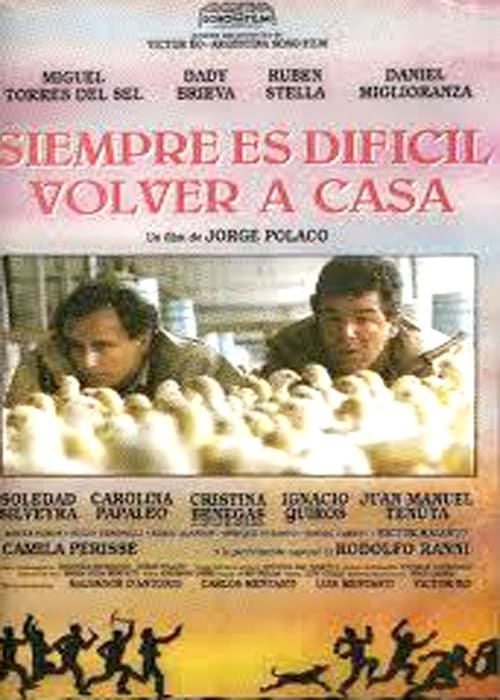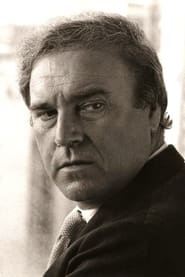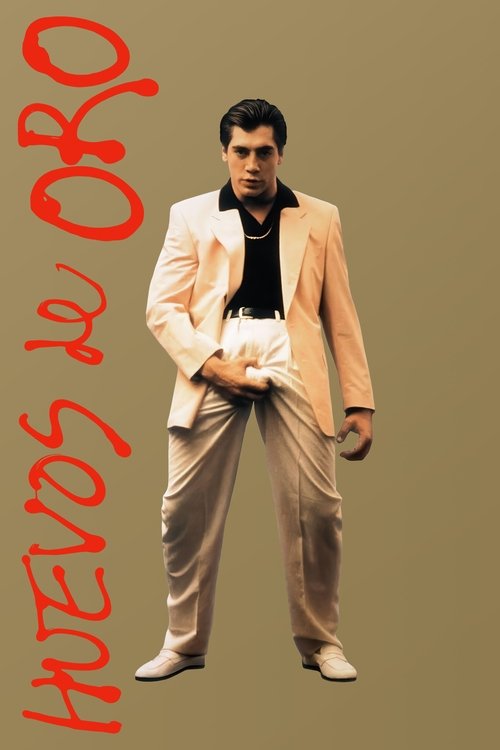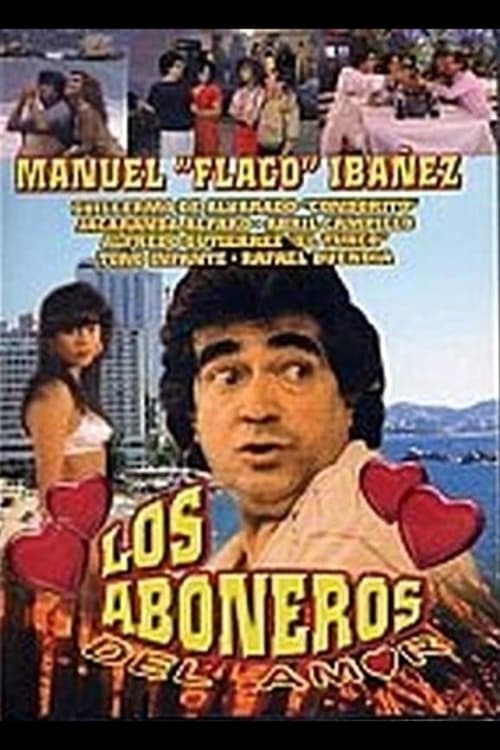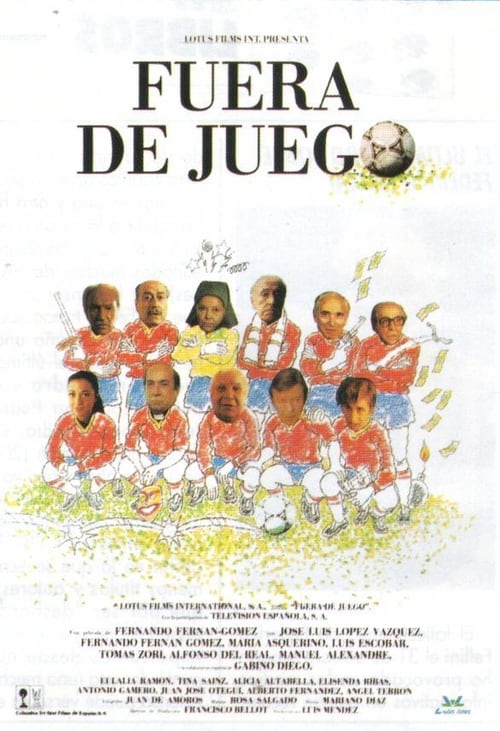
Ask Your Own Question
What is the plot?
Siempre es difícil volver a casa: Complete Plot Narrative
The film opens on a deceptively ordinary evening in a small provincial town, where four desperate men arrive with a singular purpose burning in their minds. These men--Cucurucho, Ramiro, and two others whose names fade into the background of this violent tale--have traveled to this place because one of them carries memories of childhood within its boundaries. They are men who have abandoned all pretense of hope, who no longer dream of building futures but instead focus their entire existence on extracting whatever they can from a world that has already denied them so much.
The evening begins innocuously enough. The four men crash a wedding party, inserting themselves into the celebration with the casual audacity of those who have nothing left to lose. The festive atmosphere provides them cover, allows them to observe the town, to understand its rhythms and vulnerabilities. Later that night, they venture to the local disco, where the music pulses and bodies move in the darkness. It is here, in this liminal space between respectability and transgression, that one of the men meets a woman named Julia. She is beautiful, present, alive in a way that suggests possibilities beyond the grim calculus of their criminal enterprise. They share a moment of connection, a brief respite from the weight of what they are about to do. But this moment of human warmth is merely a prelude to the violence that will consume everything.
The following morning arrives with the clarity of inevitability. The four men move toward the provincial bank with the precision of men who have planned every detail, who have rehearsed their movements until they become automatic. The robbery unfolds according to design--they enter, they take what they came for, they prepare to leave. The money is theirs. Success seems within reach. But then, in that critical moment when escape should be assured, a policeman spots them as they exit the bank. The careful architecture of their plan collapses instantly. The officer's presence transforms everything from calculated crime into desperate flight.
The men abandon their vehicle and scatter like startled animals, each running in a different direction, each suddenly alone with the consequences of their choices. Ramiro and Cucurucho manage to stay together initially, their feet pounding against the railroad tracks as they flee the town center. They run until they reach a garage, a place that seems to offer sanctuary. But sanctuary is an illusion in this world. When they attempt to hide, they encounter the mechanic working inside. In the chaos and panic of the moment, in the collision between their desperation and his innocent presence, they accidentally kill him. The first death has occurred, and it is not the last. The mechanic lies dead, his body a testament to the violence that radiates outward from their original crime.
The men separate again. Ramiro manages to find a truck and hides inside it, hoping that the vehicle's movement will carry him away from the town and its gathering fury. Cucurucho, meanwhile, stumbles into a monastery seeking refuge. But there is no sanctuary here either. Desperation transforms him into something savage. He pulls a gun on the nuns, forcing them back with threats and violence. The sacred space offers no protection, no redemption. He flees the monastery and makes his way to a blind woman's house, where he commits further violence against her, using her vulnerability as a weapon against his own fear.
The driver--the man who met Julia at the disco--faces his own nightmare. An angry mob has formed, their collective rage building like a storm. They pursue him through the streets, their numbers growing, their intent crystallizing into violence. He finds a shed and hides inside, believing he has found a moment of safety. But the mob discovers him. They torch the structure, setting it ablaze, forcing him to run once more into the open. As he flees, someone in the mob shoots him. The bullet tears through his body, but he does not fall passively into death. Instead, he turns and kills the boy who shot him, an act of defiance against the mob's collective violence. He staggers onward, wading through the river that runs through the town, his body bleeding, his mind focused on one destination: Julia's house.
He arrives at her door, and she takes him in. She is tender with him, bandaging his wounds, offering him the human kindness that has been absent from his entire experience in this town. For a moment, there is something almost redemptive in her care, something that suggests that connection and compassion might still exist in this world. But this moment of grace is shattered when a policeman storms through the door. The officer's presence transforms Julia's house into a battleground. The driver shoots the policeman, killing him, but not before the officer fires his weapon. The bullets strike both the driver and Julia, and they fall together behind an aquarium, their bodies intertwined in death. The aquarium shatters, water spilling across the floor, a visual metaphor for the destruction of everything beautiful and fragile.
The fourth member of the gang experiences a different trajectory. He encounters an artist in the town, someone who sees his desperation and offers help. For a moment, it seems that human decency might provide an escape route from the violence that has consumed the others. But the mob's reach is long and its hunger for retribution is insatiable. He is pursued relentlessly, and he flees upward, climbing to the top of the church's belltower. There, in this place of spiritual elevation, he takes a priest hostage, holding a gun to the man's head as a final bargaining chip. But there is no negotiation possible. A sniper's bullet finds him in the tower, and he falls. The priest is left standing in the belltower, traumatized but alive, a witness to the violence that has consumed the town.
Meanwhile, Ramiro experiences a moment of human connection. He encounters a woman named Susana, and they share a brief sexual encounter. It is a moment of physical intimacy, a reminder that desire and connection persist even in the midst of chaos and violence. But this moment changes nothing. It does not save him. It does not alter the trajectory of events that has already been set in motion.
Cucurucho, having escaped the blind woman's house, reunites with Ramiro. They move with purpose toward the truck in which Ramiro had originally hidden. They steal it, and for a moment--just a brief, shimmering moment--it seems that they might actually escape. The town recedes behind them. The road stretches ahead. Freedom appears possible. But then, suddenly, they are forced to stop. Truckloads of villagers arrive from multiple directions, converging on their location. They have been cornered in front of the cemetery, that place of death and finality. The townspeople emerge from their vehicles, their faces twisted with rage, their hands filled with stones.
What happens next is primal and terrible. The mob surrounds Ramiro and Cucurucho, and they begin to stone them. The camera freezes on the two men as the stones rain down upon them, as the collective violence of the town reaches its crescendo. This is not justice. This is not law. This is the pure expression of mob fury, the transformation of an entire community into instruments of death. The stones strike again and again, and the two men fall beneath the weight of the town's collective rage.
A text appears on the screen in the aftermath. It tells us that the following day, everything in the village had reverted to normal. The shops opened. The people went about their business. The routines of ordinary life resumed as if nothing extraordinary had occurred. And crucially, nobody ever knew what happened to the money. The stolen cash--the object that had set this entire chain of events in motion--vanishes from the narrative entirely. It is never recovered, never accounted for, never explained. It exists in the same liminal space as the violence itself, acknowledged but ultimately unknowable.
The film's ending is a meditation on the cyclical nature of small-town existence, on the capacity of communities to commit acts of savagery and then simply move forward as if those acts had never occurred. The townspeople had been transformed by the robbery and the subsequent violence. The hidden rancors and miseries that existed beneath the surface of their ordinary lives had erupted into the open. The criminals had become the persecuted, and the victims had become victimizers. But this transformation was temporary. By the next day, the town had reasserted its normalcy, had buried its violence beneath the routines of daily life.
The four men who arrived with such desperate purpose are now gone. One died accidentally in a garage. One was shot by a sniper in a church belltower. One was killed by police gunfire in a house with an aquarium. One was stoned to death in a cemetery. And one--or perhaps two--met their end beneath the stones of an angry mob. The money they stole remains a mystery, its fate as unknowable as the fates of the men themselves. The town has consumed them, has transformed their violence into its own, and then has simply moved on, leaving no trace of their passage except in the memories of those who witnessed the chaos. The film ends not with resolution but with erasure, suggesting that violence and crime are not exceptional events in small towns but rather eruptions of forces that always exist beneath the surface, waiting for the right catalyst to emerge.
More Movies Like This
Browse All Movies →What is the ending?
In the ending of "Siempre es difícil volver a casa," the main character, after a long and tumultuous journey, finally confronts the emotional and physical barriers that have kept him from returning home. He reconciles with his past, leading to a bittersweet resolution where he finds a sense of closure but also acknowledges the pain of what he has lost.
As the film approaches its conclusion, the protagonist, Alejandro, stands at the threshold of his childhood home, a place filled with memories both cherished and painful. The sun sets in the background, casting a warm glow that contrasts with the emotional turmoil within him. He hesitates, grappling with the weight of his past decisions and the relationships he has strained over the years.
In a series of flashbacks, we see glimpses of his life before he left: the laughter shared with his family, the arguments with his father, and the dreams he once had. Each memory is tinged with a sense of longing and regret, illustrating the complexity of his feelings towards home. As he steps inside, the familiar creaks of the floorboards echo his uncertainty.
Inside, he finds his mother, who has aged and carries the burden of their estrangement. Their reunion is fraught with unspoken words and emotions. Alejandro's heart aches as he sees the toll that time has taken on her. They share a quiet moment, filled with tension, as he struggles to express his feelings. His mother, with tears in her eyes, embraces him, signaling a tentative reconciliation.
Meanwhile, Alejandro's father, who has been a looming figure throughout the film, remains distant. The unresolved conflict between them hangs heavily in the air. Alejandro attempts to reach out, but his father's stern demeanor and unyielding pride create a barrier. The tension culminates in a confrontation where Alejandro finally voices his frustrations and fears. His father, initially resistant, begins to soften, revealing his own vulnerabilities and regrets.
As the night deepens, the family gathers for a meal, a symbolic act of unity. The atmosphere is charged with unspoken words, but there is a sense of hope as they share stories and laughter, reminiscent of better times. Alejandro realizes that while the past cannot be changed, the future holds the possibility of healing.
In the final moments, Alejandro steps outside, looking up at the stars. He reflects on his journey, understanding that returning home is not just about the physical space but about reconciling with his identity and the people he loves. The film closes with a sense of ambiguity; while there is no clear resolution to all conflicts, there is a glimmer of hope for new beginnings.
The fate of each main character is intertwined with Alejandro's journey. His mother finds solace in their reunion, while his father begins to confront his own shortcomings. Alejandro, though still carrying the weight of his past, steps into a new chapter of his life, ready to embrace the complexities of family and forgiveness.
Is there a post-credit scene?
"Siempre es difícil volver a casa," produced in 1992, does not feature a post-credit scene. The film concludes its narrative without any additional scenes after the credits roll. The story wraps up with a poignant resolution that encapsulates the emotional journey of the characters, leaving the audience to reflect on the themes of homecoming and the complexities of familial relationships. The absence of a post-credit scene reinforces the film's focus on its central narrative and the characters' internal struggles rather than extending the story further.
How does the protagonist's relationship with their family evolve throughout the film?
Initially, the protagonist's relationship with their family is fraught with tension and misunderstandings. As the story progresses, moments of vulnerability and shared memories begin to bridge the gap, leading to a gradual reconciliation. The protagonist learns to confront their past and communicate openly, which helps to mend the fractured bonds.
What role does the setting play in the protagonist's journey?
The setting serves as a character in itself, reflecting the protagonist's internal struggles. The once comforting home now feels suffocating, filled with reminders of past pain. As the protagonist navigates through familiar streets and rooms, the setting evokes nostalgia, regret, and ultimately, a sense of belonging as they come to terms with their identity.
Who are the key supporting characters that influence the protagonist's journey?
Key supporting characters include the protagonist's estranged parent, who embodies the unresolved issues of the past, and a childhood friend who represents the innocence and joy of their earlier life. These characters challenge the protagonist to confront their fears and regrets, ultimately guiding them towards healing and acceptance.
What challenges does the protagonist face when returning home?
The protagonist, upon returning home, grapples with the emotional weight of unresolved family conflicts and the stark contrast between their memories of home and the current reality. They encounter a sense of alienation, as the familiar surroundings now feel foreign, and the relationships with family members are strained due to past grievances.
What specific events trigger the protagonist's emotional breakthroughs?
Several pivotal events trigger the protagonist's emotional breakthroughs, including a heartfelt confrontation with a family member that forces them to face long-buried feelings, and a nostalgic visit to a childhood haunt that evokes powerful memories. These moments of reflection and confrontation catalyze the protagonist's journey towards understanding and forgiveness.
Is this family friendly?
"Siempre es difícil volver a casa," produced in 1992, is a film that explores complex themes of family, identity, and the emotional struggles of returning home. While it has moments of warmth and connection, there are several aspects that may be considered objectionable or upsetting for children or sensitive viewers.
-
Emotional Turmoil: The film delves into deep emotional struggles, including feelings of loss, regret, and longing, which may be intense for younger audiences to process.
-
Family Conflict: There are scenes depicting familial disagreements and tensions that can be uncomfortable, showcasing the challenges of reconciling past grievances.
-
Themes of Abandonment: The narrative touches on feelings of abandonment and the impact of separation, which could be distressing for sensitive viewers.
-
Depictions of Grief: Characters experience grief and mourning, which may evoke strong emotions and could be upsetting for children.
-
Cultural and Social Issues: The film addresses social issues that may be complex and difficult for younger viewers to fully understand.
Overall, while the film has valuable messages about family and belonging, its emotional depth and some thematic elements may not be suitable for all children or sensitive individuals.

